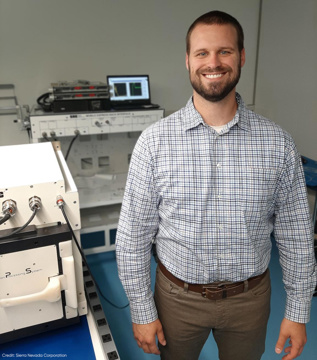Taking out the (Space) Trash with SNC Mechanical Engineer, Joe K.
July 08, 2020
 With no formal waste management in space, astronauts can accumulate a lot of trash. According to a 2018 NASA statistic, astronauts store almost two metric tons of trash before they’re able to send it away in a commercial supply vehicle. That’s more than 4,000 pounds of trash. SNC engineers are working to find a solution to that problem.
With no formal waste management in space, astronauts can accumulate a lot of trash. According to a 2018 NASA statistic, astronauts store almost two metric tons of trash before they’re able to send it away in a commercial supply vehicle. That’s more than 4,000 pounds of trash. SNC engineers are working to find a solution to that problem.
We caught up with mechanical engineer, Joe K., to learn how he and his team are taking a product some of us use every day on Earth, a trash compactor, and turning into technology astronauts can use on-orbit to help with all that space waste.
What drew you to work at Sierra Nevada Corporation (SNC) and how long have been you been with the company?
After being at SNC for almost eight years, I can say that what drew me to this company still holds true today. The unique solutions we are developing to advance human space exploration and habitation combined with the flexibility to follow projects from conceptual design through build and test make SNC an engineer’s playground.
You work on developing and building new technologies for SNC, specifically in environmental controls out of Madison, WI. What are a few examples of your most recent projects? Any favorites?
Our team in Madison specializes in developing new technologies and bringing them from a conceptual level up to prototype and flight hardware. A majority of our programs focus on scientific and logistics payloads for the International Space Station.
Recently, I’ve been leading NASA’s Next Space Technologies for Exploration Partnerships-2 (NextSTEP-2) the trash compaction development which compacts astronaut trash and recovers and recycles over 90% of the trapped water. This is especially important technology for long-duration missions where water is an extremely scarce resource. I have also been heavily involved with plant-growth payloads, including VEGGIE, Advanced Plant Habitat, and the upcoming Exposed Root On-Orbit Test System (XROOTS) payload, as well as the NextSTEP-2 LIFE™ habitat program. One of the principal challenges to growing plants in space is managing two-phase flows (water & air). SNC has invested into a unique approach my team developed to separate these flows, and we are using that gas/liquid separation technology now in both the trash compactor and the XROOTS payload, as well as looking at future applications.
I don’t think I could pick a favorite program; I enjoy the unique challenges each one offers, and working with a great team to solve them!
SNC has developed a trash compactor for future use in space. I heard you helped design a way to open and close it one-handed and be positively latched when closed. Why is that so important?
I can’t take the credit for the design! One of my team members worked on the latch details; I only assisted with the concept and con-ops. As lead engineer, I was responsible for much of the rest of the system, including the internal compression mechanism, structure, fluid handling system and electronics.
In microgravity, an astronaut will need the other hand to hold themselves in place. I always strive to build and test as much on the prototype as possible so we know the flight unit will perform – that’s why building a one-handed latch was important addition to the other flight system architecture.
What went into that process and how significant is that for astronauts who will eventually be using it?
It’s one thing to design for microgravity, but another to experience it. After flying 115 “zero-g” parabolas testing plant growth and water separation technology, I have a first-hand appreciation for designs built with human factors and ergonomics in mind. Things happen that aren’t intuitive, especially with opposing forces (and fluids). We are able to apply that experience to our designs and make sure that astronauts can easily use our hardware. Ease-of-use in a product is almost as important as functionality and performance!
What’s it like knowing astronauts in space are using the technology you helped create?
It’s incredibly inspiring and motivating! Knowing that something you designed, built and tested is in that little white dot flying across the night sky is incredibly animating and keeps me excited to see what’s next.
Why is space exploration so important to you?
Two reasons: advancements we make in new technology for space have a direct impact on life on earth and because I love to learn. Space is a new horizon and I’m fascinated by every new discovery, especially ones that I can help contribute to. That’s my favorite aspect of my job here at SNC; this shared passion drives collaboration and determination among our team to continually improve and meet challenges in the space environment, leading to new technological solutions and scientific discoveries.
---
Interested in joining the Sierra Nevada Corporation team? Apply today at sncorp.com/careers.